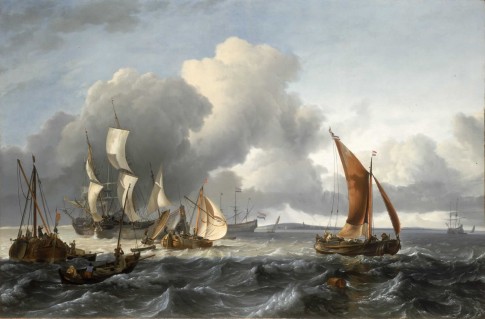By Ludolf Bakhuizen
National Maritime Museum Greenwich
The setting for the picture is the merchant shipping roadstead off the eastern coast of Texel, one of a group of northern islands guarding the entrance to the Zuider Zee. Texel Island can be seen ahead with the village of Oude Schild to the far right. The channel between the islands into the North Sea is on the horizon beyond the merchant ship furthest left. A group of three large ships is shown in the middle distance. To the left is a fluyt under sail with a larger ship passing, hidden beyond and to the right. Further back, a Dutch warship lies at anchor. Another fluyt lies at anchor on the far right. In the foreground, a group of small craft, typical of Dutch inland waterways, is tossed about by the boisterous weather. On the left, a wijdschip, with a weyschuit or punter, is lowering its sail in the immediate foreground. Another wijdschip is seen from the stern under billowing canvas, under the stern of the fluyt. On the right a kaag, a common type of ferry boat, is running before the wind with sprit-rigged mainsail and foresail.
The artist has intentionally arranged a cross section of coastal craft in the painting to demonstrate the significance of the sea. Bakhuizen was initially a calligrapher in his native Germany before moving to Amsterdam. There, he was inspired by the grisaille drawings of van de Velde, the Elder. Later, he was introduced to marine painting in oils in the studios of van Everdingen and Dubbels. He was a contemporary of van de Velde, the Younger and shared with him a concern for painting ships with accuracy and understanding. The painting is signed.
